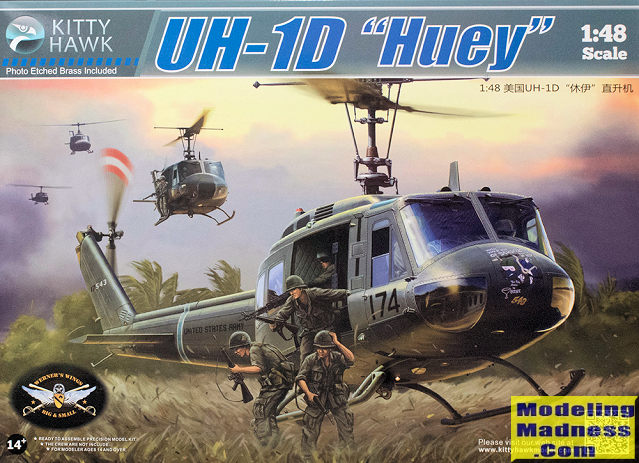
Kittyhawk 1/48 UH-1D 'Huey'
| KIT #: | KH 80154 |
| PRICE: | Around $50.00 SRP |
| DECALS: | Seven options |
| REVIEWER: | Scott Van Aken |
| NOTES: |
New tool (2017) |

| HISTORY |
The Bell UH-1 Iroquois (nicknamed "Huey") is a utility military helicopter powered by a single turboshaft engine, with two-blade main and tail rotors. The first member of the prolific Huey family, it was developed by Bell Helicopter to meet a United States Army's 1952 requirement for a medical evacuation and utility helicopter, and first flew in 1956. The UH-1 was the first turbine-powered helicopter to enter production in 1960 for the United States military, and more than 16,000 have been built since.
The Iroquois was originally designated HU-1, hence the Huey nickname, which has remained in common use, despite the official redesignation to UH-1 in 1962. The UH-1 first saw service in combat operations during the Vietnam War, with around 7,000 helicopters deployed. The Bell 204 and 205 are Iroquois versions developed for the civil market.
| THE KIT |
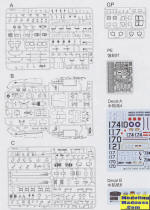 Rotorheads
have been awaiting a proper UH-1D/H for a long time. Kitty Hawk listened and got
helo guru Floyd Werner to help with developing this kit. From what I can see,
they seemed to have paid attention to the input and I have to say that you will
be very pleased with this one.
Rotorheads
have been awaiting a proper UH-1D/H for a long time. Kitty Hawk listened and got
helo guru Floyd Werner to help with developing this kit. From what I can see,
they seemed to have paid attention to the input and I have to say that you will
be very pleased with this one.
The kit has a separate boom and fuselage assembly which hints to possibly other variations being done in the future. It could also be that they don't have a mold machine big enough to handle a one-piece fuselage of this length. You'll be delighted with the interior. It has a lot of detail and includes things like separate front seat armor, full roof and interior padding, the ability to install door guns (two types), and nicely detailed instrument and upper console panels. There is raised detail on these panels and decals to fit atop them if you should so desire. The kit provides bubble plexiglas panels for the sliding doors, though the instructions do not show them being used. These would appropriate perhaps for the Luftwaffe bird. Canadian CH-118s also used these as would any SAR helo. All the doors are separate on this kit and while the instructions show them modeled closed, I see no reason why they could not be posed open. Since there are various holes in the roof to open up depending on whether you are building a D or H, that decision needs to be made early.
Kitty Hawk makes no indication as to what is used on
the D or the H so it will require a bit of research on your part. Keep in mind
that the H will have the towel rack antenna, the pitot tube on the roof, and may have the long VHF antenna on the roof, while Vietnam era aircraft will not have a cable
cutter. The H will not have the nose probes. If one simply follows the instructions verbatim, one will end up with a rather odd bird with some D bits and some post war H bits. Those who are familiar with the
aircraft, feel free to contact me with corrections
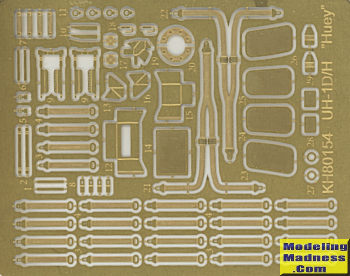 if I missed
something.
if I missed
something.
There is a complete engine provides so that if you want to show the engine compartment doors open, you may do so. The kit includes a hoist housing on the underside, something I've not seen on other UH-1 kits. Most of the photo etch is for belts and harnesses with some for engine cooling screens. A set of p.e. door pockets are also on the fret along with some other smaller items.
I'm not sure how tail heavy this will be, but I always try to put some weight under the floor as far forward as I can just in case. Both the detail on the main and tail rotor assemblies is quite good. I like that the windscreen piece is one of the last to be installed as it will make it easier to mask off the airframe.
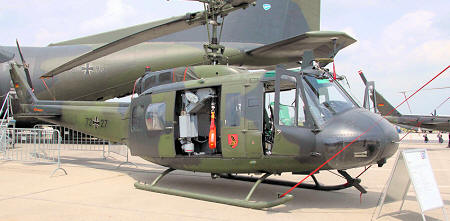 Instructions
are very nicely done with color information provided by Gunze paint references.
These aircraft all use pretty standard colors so there should be no issues in
finding the right ones. The only ones that are not overall OD are th
Instructions
are very nicely done with color information provided by Gunze paint references.
These aircraft all use pretty standard colors so there should be no issues in
finding the right ones. The only ones that are not overall OD are th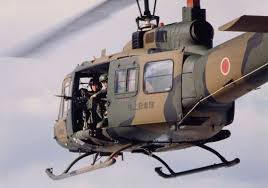 e
German one in olive green and black (as in NATO Black) and the Japanese version
that has 'earth green', grey, and 'light green'. Actually, I think the grey
should be black while the earth green is actually a brown. I have provided
photos of both the German and Japanese color options. You decide.
e
German one in olive green and black (as in NATO Black) and the Japanese version
that has 'earth green', grey, and 'light green'. Actually, I think the grey
should be black while the earth green is actually a brown. I have provided
photos of both the German and Japanese color options. You decide.
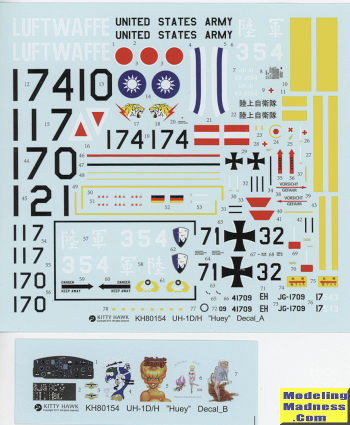 There are
seven markings option provided of which four of them are listed as Vietnam era
UH-1Ds. In addition there is a JSDF UH-1H, a Taiwanese UH-1H and a Luftwaffe
UH-1D, so you have a nice variety of markings options right out of the box. All
of the illustrations show UH-1Hs. The units are generally provided, but no
indication as to the date of the aircraft. Now this presents a bit of an issue
for those who are wanting to be totally accurate. You see, the H was present in
Vietnam and many D aircraft were upgraded to H standard. According to Wiki,
production UH-1H aircraft were first delivered in September 1967 and would have
been in country soon after. You can see that information on the date of the
markings option would be useful. This is one area that Kitty Hawk needs to
improve. The decals themselves are very nicely done and past experience with
them has been mostly positive.
There are
seven markings option provided of which four of them are listed as Vietnam era
UH-1Ds. In addition there is a JSDF UH-1H, a Taiwanese UH-1H and a Luftwaffe
UH-1D, so you have a nice variety of markings options right out of the box. All
of the illustrations show UH-1Hs. The units are generally provided, but no
indication as to the date of the aircraft. Now this presents a bit of an issue
for those who are wanting to be totally accurate. You see, the H was present in
Vietnam and many D aircraft were upgraded to H standard. According to Wiki,
production UH-1H aircraft were first delivered in September 1967 and would have
been in country soon after. You can see that information on the date of the
markings option would be useful. This is one area that Kitty Hawk needs to
improve. The decals themselves are very nicely done and past experience with
them has been mostly positive.
| CONCLUSIONS |
This is very much a great looking kit. It will take careful building as all Kitty Hawk kits have rather tight tolerances. They are not 'impossible' to build. There is quite a bit of detail in this one and it seems to me that you can build it all buttoned up if you so desire. I had no real trouble with their UH-1Y and I expect this one to be even better. Though the kit offers a ton of great options, I'm sure the aftermarket crowd will be gearing up for this one so stay tuned!
| REFERENCES |
https://en.wikipedia.org/wiki/Bell_UH-1_Iroquois
If you would like your product reviewed fairly and fairly quickly, please contact the editor or see other details in the Note to Contributors.
Back to the Main Page Back to the Review Index Page Back to the Previews Index Page